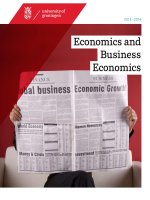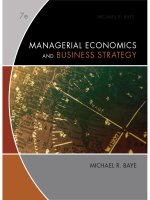Managerial economics and business strategy chap 1
Bạn đang xem bản rút gọn của tài liệu. Xem và tải ngay bản đầy đủ của tài liệu tại đây (881.68 KB, 57 trang )
CHAPTER 1
The Fundamentals of
Managerial Economics
Contents
I.
II.
Introduction
The Economics of Effective Management
I.
Identify Goals and Constraints
II. Recognize the Role of Profits
III. Five Forces Model
IV. Understand Incentives
V. Understand Markets
VI. Recognize the Time Value of Money
VII. Use Marginal Analysis
Copyright © 2014 by the McGraw-Hill Companies, Inc. All rights
reserved.
2-2
Chapter One
Chapter Overview
Learning objectives
• Summarize how goals, constraints, incentives, and
market rivalry affect economic decisions.
• Distinguish economic versus accounting profits and
costs.
• Explain the role of profits in a market economy.
• Apply the five forces framework to analyze the
sustainability of an industry’s profits.
• Apply present value analysis to make decisions and
value assets.
• Apply marginal analysis to determine the optimal level
of a managerial control variable.
• Identify and apply six principles of effective managerial
decision making.
1-3
Introduction
Chapter Overview
Chapter 1 focuses on defining managerial economics, and
illustrating how it is a valuable tool for analyzing many business
situations.
=> Billions of dollars are lost each year because many existing
managers fail to use basic tools from managerial economics to:
• shape pricing and output decisions
• optimize the production process and input mix
• choose product quality
• guide horizontal and vertical merger decisions
• optimally design internal and external incentives
=> Managerial economics is not only valuable to managers of
Fortune 500 companies; it is also valuable to managers of not-forprofit organizations.
=> In fact, managerial economics provides useful insights into every
facet of the business and nonbusiness world in which we live—
including house- hold decision making.
1-4
Introduction
• This chapter provides
managerial economics.
an
Chapter Overview
overview
of
– How do accounting profits and economic profits
differ?
• Why is the difference important?
– How do managers account for time gaps between
costs and revenues?
– What guiding principle can managers use to
maximize profits?
1-5
The Manager
Introduction
• A person who directs resources to achieve a
stated goal.
– Directs the efforts of others.
– Purchases inputs used in the production of the
firm’s output.
– Directs the product price or quality decisions.
1-6
Introduction
Economics
• The science of making decisions in the
presence of scarce resources.
– Resources are anything used to produce a good or
service, or achieve a goal.
– Decisions are important because scarcity implies
trade-offs.
– Time is one of the scarcest resources
1-7
Introduction
Managerial Economics Defined
• The study of how to direct scarce resources in the way
that most efficiently achieves a managerial goal.
– Should a firm purchase components – like disk drives and
chips – from other manufacturers or produce them within
the firm?
– Should the firm specialize in making one type of computer
or produce several different types?
– How many computers should the firm produce, and at what
price should you sell them?
– How you ensure employees work hard and produce quality
products?
– How will the actions of rival computer firms affect your
decisions?
The key to making sound decisions is to know what
information is needed to make an informed decision and then
to collect and process the data.
1-8
Economics of Effective Management
Economics of Effective Management
• Basic principles comprising effective
management:
– Identify goals and constraints.
– Recognize the nature and importance of profits.
– Understand incentives.
– Understand markets.
– Recognize the time value of money.
– Use marginal analysis.
1-9
Economics of Effective Management
Identify goals and constraints
• Knowing your goals allows you to identify
which decisions you need to make.
• Contraints make it difficult for managers to
achieve goals.
1-10
Economics of Effective Management
The Nature and Importance of Profits
• A typical firm’s objective is to maximize profits.
• Accounting profit
– Total amount of money taken in from sales (total
revenue) minus the dollar cost of producing goods or
services.
• Economic profit
– The difference between total revenue and the total
opportunity cost of producing goods or services.
– Opportunity cost
• The explicit cost of a resource plus the implicit cost of giving
up its best alternative use of the resource
1-11
Economics of Effective Management
The Nature and Importance of Profits
– Implicit costs are very hard to measure and
therefore managers often overlook them.
– Effective managers, continually seek out data from
other sources to identify and quantify implicit
costs.
1-12
Economics of Effective Management
The Nature and Importance of Profits
– Suppose you own a building in New York that you
use to run a small pizzeria. Food supplies are your
only accounting costs.
– At the end of the year, your accountant informs
you that these costs were $20,000 and that your
revenues were $100,000.
Þyour accounting profits =?
ÞHowever, these accounting profits overstate your
economic profits because the costs include only
accounting costs
1-13
Economics of Effective Management
The Nature and Importance of Profits
1. The costs do not include the time you spent
running the business.
Þsuppose you could have worked for someone
else for $30,000. Your opportunity cost of time
would have been $30,000 for the year.
Þ$30,000 of your accounting profits are not
profits at all but one of the implicit costs of
running the pizzeria.
1-14
Economics of Effective Management
The Nature and Importance of Profits
2. Accounting costs do not account for the fact
that, had you not run the pizzeria, you could have
rented the building to someone else.
If the rental value of the building is $100,000 per
year, you gave up this amount to run your own
business.
=> Economic profits = Revenue –Opportunity
cost?
1-15
The Nature and Importance of Profits
• Joe faced the following options: (a) pay $5,000
in tuition to attend classes at Econ Tech; (b)
work as a fry cook for $4,000; or (c) work as a
waiter at an elite restaurant and earn $10,000.
What is Joe's opportunity cost of attending
classes at Econ Tech?
2-16
Economics of Effective Management
The Role of Profits
• Profit Principle:
– Profits are a signal to resource holders where
resources are most highly valued by society.
– When firms in a given industry earn economic
profits, the opportunity cost to resource holders
out- side the industry increases. Owners of other
resources soon recognize that, by continuing to
operate their existing businesses, they are giving
up profits.
– This induces new firms to enter the markets in
which economic profits are available. As more
firms enter the industry, the market price falls,
and economic profits decline.
1-17
Economics of Effective Management
Five Forces and Industry Profitability
Entry
•entry heightens competition and reduces the margins of
existing firms in a wide variety of industry settings.
Power of
Input Suppliers
•Industry profits tend to
be lower when suppliers
have the power to
negotiate favorable
terms for their inputs.
Industry Rivalry
•Rivalry tends to be less intense (and
hence the likelihood of sustaining
profits is higher) in concentrated
industries—that is, those with
relatively few firms.
Level, Growth,
and Sustainability
of Industry Profits
Power of Buyers
•industry profits tend
to be lower when
customers or buyers
have the power to
negotiate favorable
terms for the products
or services produced in
the industry.
Substitutes & Complements
•The level and sustainability of industry
profits also depend on the price and
value of interrelated products and
services
1-18
Economics of Effective Management
Five Forces and Industry Profitability
Entry
•Entry Costs
•Speed of Adjustment
•Sunk Costs
•Economies of Scale
•Network Effects
•Reputation
•Switching Costs
•Government Restraints
Power of
Input Suppliers
Power of
Buyers
•Supplier Concentration
•Price/Productivity of
Alternative Inputs
•Relationship-Specific
Investments
•Supplier Switching Costs
•Government Restraints
Level, Growth,
and Sustainability
of Industry Profits
Industry Rivalry
•Concentration
•Price, Quantity, Quality,
or Service Competition
•Degree of Differentiation
•Switching Costs
•Timing of Decisions
•Information
•Government
Restraints
•Buyer Concentration
•Price/Value of Substitute
Products or Services
•Relationship-Specific
Investments
•Customer Switching Costs
•Government Restraints
Substitutes & Complements
•Price/Value of Surrogate Products •Network Effects
or Services
•Government
•Price/Value of Complementary
Restraints
Products or Services
1-19
Economics of Effective Management
Understand Incentives
• Changes in profits provide an incentive to
resource holders to change their use of
resources.
• Within a firm, incentives impact how
resources are used and how hard workers
work.
– One role of a manager is to construct incentives to
induce maximal effort from employees.
1-20
Economics of Effective Management
Understand Markets
• Two sides to every market transaction:
– Buyer (consumer).
– Seller (producer).
• Bargaining position of consumers and
producers is limited by three rivalries in
economic transactions:
– Consumer-producer rivalry.
– Consumer-consumer rivalry.
– Producer-producer rivalry.
• Government and the market.
1-21
Economics of Effective Management
Understand Markets
ConsumerProducer
Rivalry
Consumers
attempt to
negotiate low
prices, while
producers
attempt to
negotiate high
prices.
ConsumerConsumer Rivalry
ProducerProducer Rival
Scarcity of goods
Scarcity of
reduces the
consumers
negotiating
causes producers
power of
to compete with
consumers as
one another for
they compete for
the right to serve
the right to
customers.
Government the Market
Disciplines the
market process
purchase those
goods.
1-22
Economics of Effective Management
Understand Markets
Southwest Airlines begins a “Bags Fly Free”
campaign, charging no fees for the first and
second checked bags. Does this situation best
represent
producer–producer
rivalry,
consumer–consumer rivalry, or consumer–
producer rivalry?
Explain.
1-23
Economics of Effective Management
The Time Value of Money
• a gap exists between the time when costs are
borne and benefits received.
– $1 today is worth more than $1 received in the
future.
• The opportunity cost of receiving the $1 in the future is
the forgone interest that could be earned were $1
received today
– Managers can use present value analysis to
properly account for the timing of receipts and
expenditures.
1-24
Economics of Effective Management
Present Value Analysis 1
• Present value of a single future value
– The amount that would have to be invested today
at the prevailing interest rate to generate the
given future value:
𝐹𝑉
𝑃𝑉 =
1+𝑖 !
– Present value reflects the difference between the
future value and the opportunity cost of waiting:
𝑃𝑉 = 𝐹𝑉 − 𝑂𝐶𝑊
1-25









